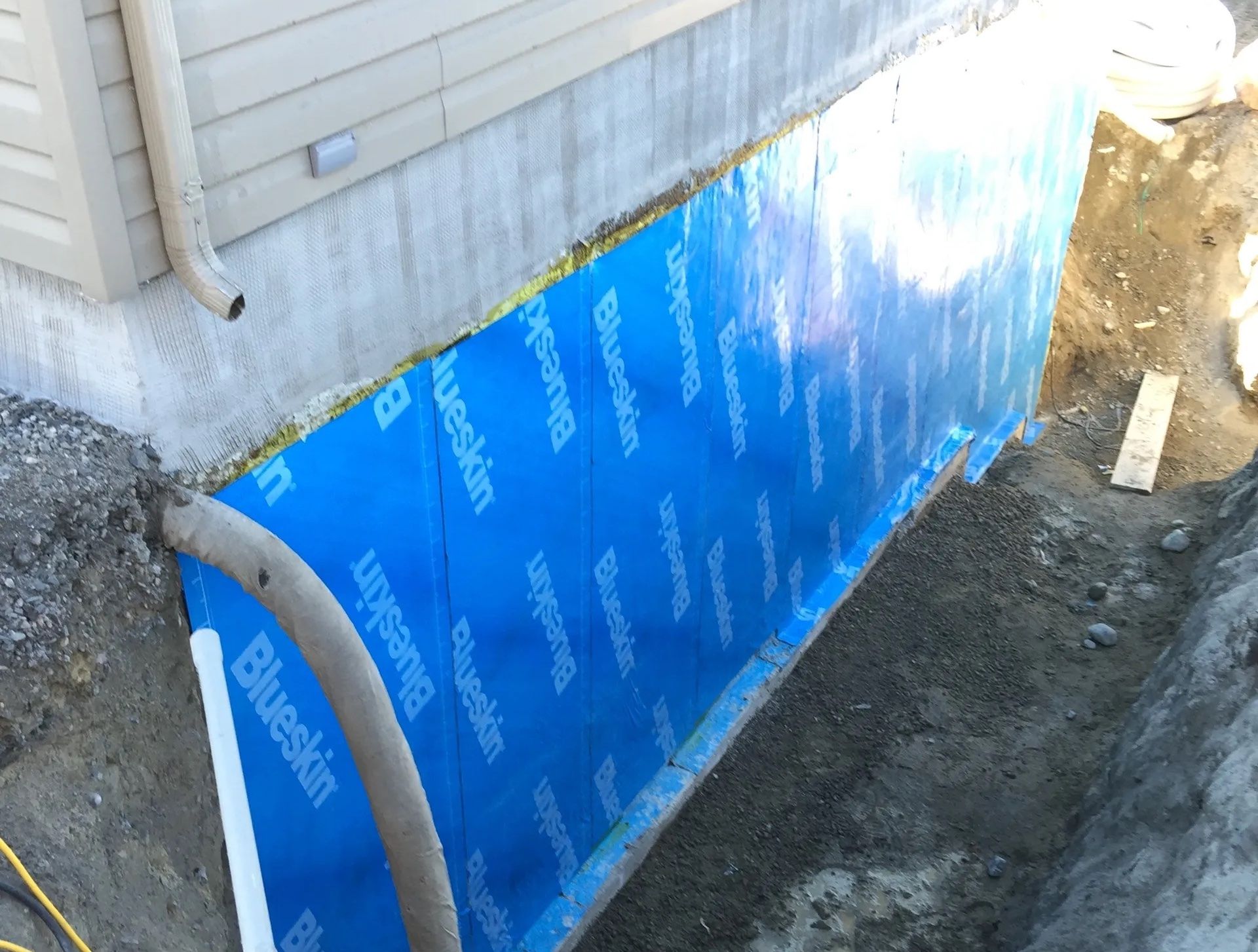⎯ services
Weeping Tile & Waterproofing
Provided by the best foundation specialists in Sudbury & Northbay ON.
Weeping tile collects groundwater, while waterproofing membranes prevent water penetration.
5 out of 5 stars on Google
Contact Us For All Your Sudbury & North Bay Foundation Needs.

Weeping Tile
Weeping tile is a porous pipe system installed around the perimeter of a building foundation to collect and redirect groundwater away from the structure and footing. Our foundation specialists provide expert weeping tile installation and repair services in Sudbury & North Bay, ON, ensuring your home stays protected from water damage.
How Weeping Tile Works:
- Weeping tile must be installed on the exterior, at the base of the footing
- As groundwater accumulates around the foundation, it enters the perforations or porous surface of the weeping tile.
- The collected water is then channeled into a drainage system, such as a sump pump or storm sewer, preventing it from seeping into the basement
- By maintaining a consistent level of moisture around the foundation, weeping tile helps alleviate hydrostatic pressure, reducing the risk of foundation cracks and water infiltration.
Benefits of Weeping Tile
- Effective Drainage: Weeping tile provides an efficient means of managing groundwater, reducing the likelihood of basement flooding and water-related damage.
- Preventative Measure: By directing water away from the foundation, weeping tile helps protect the structural integrity of the building, prolonging its lifespan.
- Versatility: Weeping tile systems can be customized to suit the specific needs and challenges of different properties, making them a versatile solution for waterproofing applications.
Waterproofing
Waterproofing membranes are thin layers of material applied to surfaces to prevent water from passing through.
Benefits of Waterproofing Membranes
- Waterproofing: The primary function of membranes is to prevent water from penetrating building structures, thereby protecting them from moisture-related damage.
- Flexibility: Many membranes possess excellent flexibility, allowing them to adapt to the contours of the surface and accommodate structural movements without compromising their effectiveness.
- Durability: High-quality membranes offer long-term protection against water infiltration, ensuring the structural integrity of your property for years to come.
Beyond the Basics:
Maximizing the Performance of Your Weeping Tile System
When Do You Need It?
Early intervention saves money. Consider weeping tile installation if you notice:
- Musty odours, efflorescence, or damp spots on basement walls.
- Seasonal pooling near the footing or window wells.
- Frequent sump pump cycling after rain or snowmelt.
- Hairline cracks are widening over time due to hydrostatic pressure.
A professional assessment identifies the true moisture path and confirms if weeping tile installation is the proper remedy or part of a broader waterproofing plan. Our foundation specialists proudly serve Sudbury & North Bay, ON, providing expert guidance and tailored solutions to protect your property.
What’s Included in a Professional Install
We go further than basic pipe-and-gravel:
- Diagnostic start-up: moisture mapping, exterior grading review, and downspout routing.
Cleanouts & access ports: future maintenance without excavation. - High-flow discharge planning: tie-in to sump pit or approved storm outlet, with backflow protection.
- Foundation protection: membrane or dimple board, plus careful backfill compaction to protect parging.
Optional Upgrades That Pay Off
Tailor your system to the property:
- Sump pump redundancy: primary + battery backup with high-water alarm.
- Window well drains: direct connections to the perimeter line.
- Surface water control: re-grading, swales, and downspout extensions to keep bulk water away.
- Camera verification: video record of the new line for your files and future resale.
Maintenance That Extends Service Life
Even the best system benefits from light, planned care:
- Annual cleanout port inspection and optional hydro-flush.
- Seasonal check of discharge lines for ice or debris.
- Gutter cleaning and downspout direction review after major storms.
Ask about our maintenance plan to keep your
weeping tile installation in peak condition.
Interior vs. Exterior Solutions—Choosing Wisely
- Exterior weeping tile installation relieves pressure at the source and protects the footing—best for long-term resilience.
- Interior drainage can be a targeted retrofit for finished spaces or when exterior access is limited. After a site visit, we’ll recommend the most cost-effective blend.
Compliance, Materials, and Documentation
We use quality, code-compliant components: perforated pipe sized for the site, uniform washed stone, and geotextiles selected for local soils. You’ll receive as-built notes, discharge routing details, and maintenance guidance for records and insurance
Why Homeowners Choose Foundation Masters
- Northern Ontario expertise with proven cold-weather detailing.
- Clean worksite practices that protect landscaping and access.
- Transparent pricing, documented scope, and a strong warranty on waterproofing and weeping tile installation services—up to 25 years on eligible work.
Ready to Protect Your Basement?
Book an on-site inspection. We’ll diagnose the issue, present options, and provide a precise quote for weeping tile installation and complementary waterproofing—no fluff, just solutions that keep your foundation dry and stable.
Frequently Asked Questions
1. What’s the practical difference between weeping tile and waterproofing—and why do I need both?
Weeping tile manages groundwater at the footing; waterproofing protects the wall surface. Think of drainage as moving water away, and waterproofing as stopping contact. Both reduce hydrostatic pressure, keep moisture off concrete, and lower the chance of leaks returning after heavy rain or spring melt. Pairing exterior drainage with a quality membrane gives you defence-in-depth rather than relying on a single barrier that can be overwhelmed.
2. Will exterior work damage my landscaping or hardscaping?
Excavation is carefully planned to protect high-value elements. Access paths, plywood mats, and soil stockpiles are managed to minimize disturbance. Crews photograph pre-existing conditions, protect walkways, and separate topsoil for reinstatement. After weeping tile installation and membrane work, backfill is compacted, and areas are restored to a neat, safe condition. If you’re planning landscape upgrades, this is an ideal time to coordinate final grading and downspout extensions.
3. What materials are used in modern weeping tile systems?
Contemporary systems use perforated PVC or HDPE pipe surrounded by washed stone for rapid flow. A geotextile wrap helps keep fines out, and a dimpled drainage board protects the wall while creating a drainage plane. Connections lead to a sump or approved storm outlet with backflow protection. Quality materials matter; paired with correct trench depth, slope, and clean stone, they provide reliable, long-term performance in clay-rich or freeze–thaw environments.
